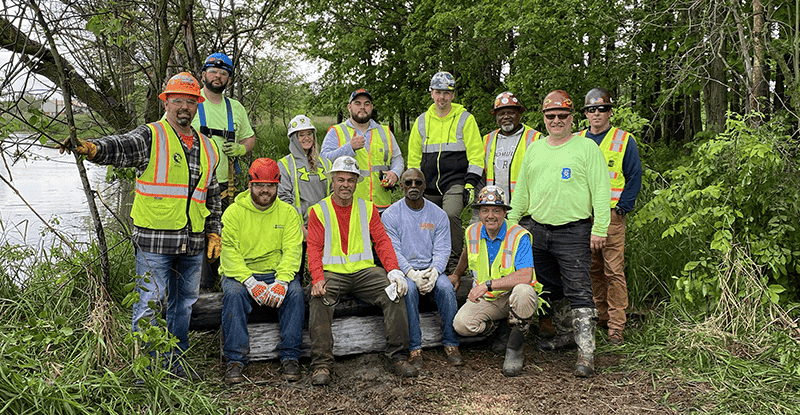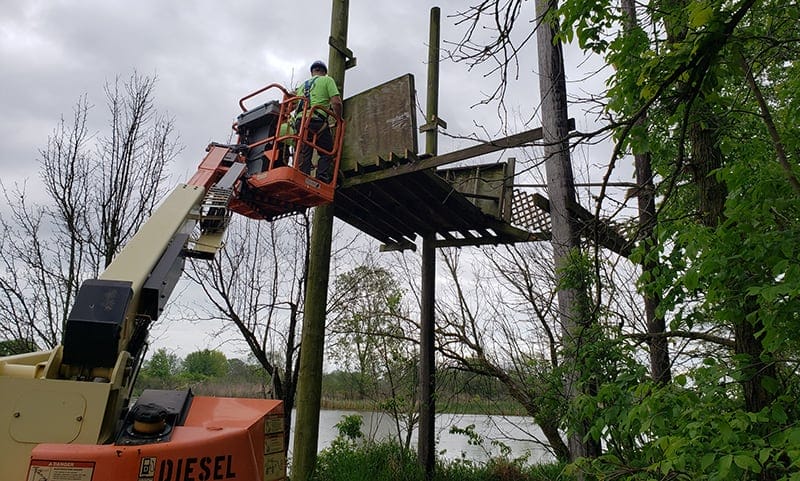Union Volunteers Help Open Sections of Detroit River IWR to the Public
Through the Union Sportsmen’s Alliance’s (USA) Work Boots on the Ground (WBG) conservation program, union volunteers from Sheet Metal Workers (SMART) Local 80, Operating Engineers (IUOE) Local 324, Laborers’ (LIUNA) Local 1191 and Plumbers and Pipefitters (UA) Local 671 completed several safety projects necessary to create access to a parcel of land in the Detroit River International Wildlife Refuge (DRIWR) that has never been open to the public. In all, volunteers donated 174 hours of labor, valued at more than $9,000, to complete the project.

Union volunteers donated 174 hours of labor to complete projects at the Detroit River IWR.
The only international wildlife refuge in the United States, the DRIWR was established in 2001 by the U.S. Fish and Wildlife Service in cooperation with Canada, as well as conservation leaders and local communities in both countries, with the goal of building a sustainable future for the Detroit River and western Lake Erie ecosystems.
At 6,200 acres in size, the DRIWR is made up of 19 separate refuge units that provide critical wetland, upland and beach ridge habitats, especially for waterbirds, waterfowl and other birds during the migration seasons, according to Deputy Refuge Manager Steve Dushane. The lower Detroit River and western Lake Erie offers some of the best waterfowl hunting in the country.
“The 43-acre Taylor Unit was donated to the refuge several years ago, but an old access bridge in the middle of the parcel would need to be abandoned or inspected prior to providing any public access to the unit. The bridge inspection determined it was in good conditions, but railings were required to continue use. Without the bridge, a significant portion of the property would not have access,” said Dushane, “In addition, an observation tower the private owner had erected years before was in disrepair and unsafe.”
Thirteen volunteers from the SMART, LIUNA and IUOE locals, including project leader and SMART Local 80 Business Agent Bryan McConnell, demolished and removed the aging tower in the first phase of the mission.

Thirteen volunteers demolished and removed the aging tower.
Then, using materials supplied by the DRIWR, five volunteer apprentices with Pipefitters Local 671 designed, fabricated and installed the handrails needed to make the large and sturdy bridge safe for public use.
“They were designed to be removable,” added Mc Connell, “so that refuge personnel can move heavy equipment into the parcel when needed.”
Plans for use of the Taylor Unit, once opened, have not been finalized, but Dushane explained that they will likely focus on environmental/outdoor education.
“Clive Taylor, who donated the land, did a remarkable job of turning the agricultural fields back into wetlands and ponds on his own,” he said, “and he was the one who suggested that it be dedicated to public education. So, while nothing has been decided, I can envision its focus being on educating people on the value and benefits in restoring and protecting natural habitat and just interacting with nature.
“The partnership between the Union Sportsmen’s Alliance and the Detroit River International Wildlife Refuge has been the first step in making it happen,” he continued. “The USA’s assistance through its volunteer members assists us with accomplishing things we could not otherwise get done due to staff limitations. The tower removal and bridge railing projects at the Taylor Unit would not have been completed for some time without our valuable partnership.”



